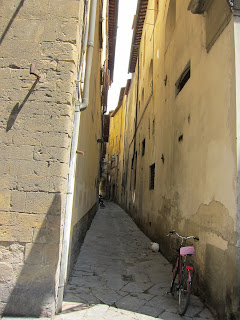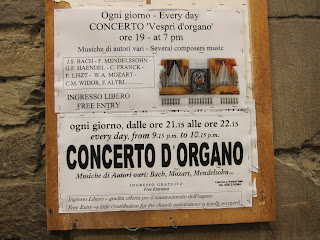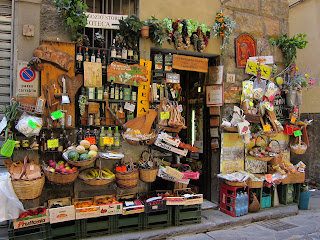6/14
Another day, another tour! Today we had Marko again for a walk about the city center.As an aside I have to share some of Marko's funny gems from the day before. Explaining the differences between how Italians perceive Italians and the way that Americans think of them, he gave the following example:
"You call Leonardo da Vinci, "da Vinci." But for us this is very strange because da Vinci means 'from the city of Vinci,' so we call him Leonardo. Anyone coming from Vinci can be called da Vinci. For example I have a wife from Vinci. So I can say I that I have a da Vinci wife! (the whole room exploded in laughter and the director of the program, also a Florentine, named Elizabette who was sitting behind me, couldn't stop chuckling even when the rest of us did. In whispers I could hear, "Ha! da Vinci wife! Ha!" : D
As you can tell Marko has charm. Charm that I think is very typically Italian, possibly specifically Florentine. He speaks with great pride about his native city more than he speaks with pride about Italy. From his brief description of his own academic work (he specializes in contemporary and modern American art) he indicated that he enjoys American culture and considers it the future, much like he considers the Renaissance as the historical apex of Florence. His anecdotes are amazing.
Remnants of Roman motifs in Florence. An open air market under open arches in the city center.
Marko says, with clear conviction, that in Florence (and Europe) artists are always looking back to the past. But in America the artist doesn't have the burden of a long history and can look to the future.
My favorite quote too, was when there was a problem with a projector for his PowerPoint, Marko looks up at us like he doesn't know what to do. Someone says, 'Oh let me help you' and he says with a smirk, "...I know with all you Californians I never have to worry about my comp-u-ters because you can fix them. You invented them!" Chuckle. Chuckle.
~~~~~~
Anyhow, Marko in the lead, we began our walk of the medieval city at the Piazza della Republica. This was the central square of the Ancient Roman city and is still the historical and geographical navel of Firenze. From the Development of Florence lecture we had on Monday, the Roman city ruins are beneath the entire city.
Central places like the Duomo are built over significant Roman sites. There are still remnants of the Roman city in the Florence of today, one of which is the perfect recto-linear shape of this piazza and its North, South, East, West layout (typically Roman). One of the streets that make up the piazza, Via Roma, remembers the Roman city.
The reasons why the Roman ruins are not visible in Florence is that they are some 15 feet beneath the city streets and also because the raw material of the stone was used by the people of Florence to build other buildings. This site, which would have been the forum, was later a central market. To one side, was the historic ghetto for Jews (one of the poorest neighborhoods in Florence after the pope decreed that Jews should be segregated.) At the time of Garibaldi, a huge synagogue was built and still stands very near the building where we have classes. This is partly because Garibaldi and the unification of Italy was a movement against the church.
At the time of the unification of Italy, when Florence briefly became the capital of Italy, the market was shut down and moved to the Mercato Centrale (where I buy all my yummy treats) and the 19th century buildings of the piazza were erected in place of the older ones. According to an inscription on one of the buildings, construction ended in 1895. The inscription reads, "the old city center which became squalid, has had a new birth" - a reference to the Renaissance that shows how Florence is always looking back to the past.
In this area, which is one of the oldest in the city, there is a very eclectic mix of medieval, renaissance, and contemporary buildings. Somehow they all become Florence, without dissonance in their overall aesthetic.
In this area, which is one of the oldest in the city, there is a very eclectic mix of medieval, renaissance, and contemporary buildings. Somehow they all become Florence, without dissonance in their overall aesthetic.
The oldest Medieval tower in downtown Florence that has now been incorporated into a hotel
One of the very interesting details found on the buildings of the city: a wrought iron ring to which a horse can be tied.
A typical Medieval Street. Just wide enough for a horse or bicycle to get through
The relationship between the Church and Italians was somewhat strained and when unification occurred under the king, Florence temporarily became the capital (1861-67). At the time Rome was under the control of the Pope. In 1871, the people of Italy were able to take Rome and the pope was exiled to the Vatican. The city did not become the permanent capital of Italy, but remnants of the changes to Florence can still be seen throughout the city today. It was the reason why the old city walls were destroyed to build large avenues around the city center and it was one of the reasons that Florence finally had enough money to build a facade for Santa Maria del Fiore (the Duomo).
From the Piazza della Republica we walked to the Duomo, beneath which are the ruins of a Roman temple and an early Christain church called Santa Reparata. Construction on the Duomo began in 1296.
The style of this great basilica is Italian Gothic with an added neo-Gothic facade from the 1800s.
The church ground floor is built with a floor beneath the level of the piazza which houses it. Leonardo (da Vinci) tried to convince the people of Florence that he could lift the whole cathedral up using pullies and technology he had worked out in order to fix the problem of the church being below ground level. According to Marko, da Vinci was an interesting man and very convincing in his arguments. Vasari who wrote about the artists of Florence said that the people who would come to hear Leonardo speak stood riveted, but when he left they would shake their heads. :)
Across from the Duomo is the oldest church in the city: the baptistery. Marko, was very funny in explaining the layout of the baptistery and the Duomo, which face one another.
At the time of Early Christianity and medieval Europe, when pagans were still present in the city, they could not enter the Cathedral without being baptized. Marko told us to think about the baptistery as a "sin wash," kind of like a car wash :) you get baptized, wash away your sins, and then you can enter the cathedral.
The Baptistery (left front) and the Duomo in the back at night
At the time of Early Christianity and medieval Europe, when pagans were still present in the city, they could not enter the Cathedral without being baptized. Marko told us to think about the baptistery as a "sin wash," kind of like a car wash :) you get baptized, wash away your sins, and then you can enter the cathedral.
When the church was built, the richly decorated Roman sarcophagi found in the square were incorporated into the baptistry walls. They can still be seen there and apparently inside. According to Marko, having Roman sarcophagi present within the structure of the church gave an extra value to it.
Here Marko showed us the original doors of the baptistery which date to the 13th century, as well as the copy of the Paradiso Gate which was replaced in 1990 when the world cup came to Florence. This replacement was paid for by a Japanese exporter of Italian fashion (Gucci) and created from a mold taken from the original in WWII - when there was a fear that the baptistery could be destroyed. A copy of the doors is at Grace Cathedral in downtown San Jose! Guess where I'm going to go when I get back home?
The Duomo facade. According to Marko, Florentines don't like it. The Gothic revival doesn't go with the rest of the decoration. Marko said, "so maybe in a couple hundred years, we will like it." :)
The bell tower, "companile" because "compagna" means bell was designed by Giotto, one of the world's most significant painters.
In the bottom row of designs we see human activity, next up the planets that influence human activity and the top row the prophets of Christ. Arnolfo, a little known artist, was the first designer/architect of the Duomo.
The Duomo was begun in 1296 and consecrated in 1436 (nearly a 150 years later). The entire building is Gothic, except for the dome which is Renaissance. The open space contrasts with the dark streets of the Middle Ages surrounding the piazza. It is full of light. Entering into the openness of the piazza out of the medieval streets surrounding the church- the city's spiritual center- is equal to entering into the light from darkness - related to the spiritual experience of baptism, communion, etc.
The most famous Italian of all time, Dante Aligheri, was baptized in the Baptistery and remembered this church fondly in his writing.
Statue of Dante Aligheri outside Santa Croce
After visiting the piazza and discussing it's architecture, Marko led us into the area to the right of the facade of the Duomo through a part of the medieval city. Here there were remnants of the first university of Florence, where the great artists studied. Impressions. Old medieval towers. Dark streets with little cafes and restaurants. Treasures in shops. Bicycles. Vespas. Potentially cars. The House of Dante and the church where Beatrice was supposedly married and buried is here. Having read Dante's comedy recently (Carmel!) walking where Dante and Beatric lived is super, duper exciting!
Sign for Dante's Church (Where Beatrice was supposedly buried)
The Door
There are free organ concerts here, every night and I am hoping to go and see one soon.
All of these amazing places of Italy's greatest writer are on Via Dante
Marko called Dante "the greatest Italian" because he was the father of the modern Italian language. Instead of writing his comedy in Latin, he wrote it in the vulgar Italian dialect spoken in Florence. As a result, Marko explained proudly, modern Italian that is taught in all the schools of Italy is based on the Florentine dialect!
Called the comedy, not the divine comedy, by Italians Dante's great masterpiece and the author himself is widely celebrated in the city. Marko pointed out that Florence is very much a part of Dante. According to his portraits he had a large prominent nose. "Just like me," Marko remarks. It is "Florentine."
Here is a little cafe in this neighborhood that remembers the father of the Italian language and his master work.
We then came to the Uffizzi, or "offices." This building is now the greatest museum in Italy. In this Piazza are some of Italy's best statues (or their replicas), still placed outside for all to see.
It is also where Savanorolla, the radical religious and political figure (he wanted to end the Medici monarchy and return the city to a popular republic), was put to death.
Here is a very early Romanesque church that we visited:
At the end of our walk we passed some shops and I took pictures of some more window displays. From my travels, thus far, Florence has amazing ones.

Here is a very early Romanesque church that we visited:
At the end of our walk we passed some shops and I took pictures of some more window displays. From my travels, thus far, Florence has amazing ones.
A display with books opened. If you look closely, my roommate Laura is taking a picture of it too!

I loved this moody/pensive cafe owner. I like to imagine him impatiently waiting on an truck delivery.
After finishing this lecture I decided to break from the group and take a solitary walk. It's fun hanging out, but I also love being alone when exploring the city. I walked across the Santa Trinita bridge to the other side of Florence, briefly explored the area and walked back along the Arno to the Ponte Niccolo (super far away) before getting lost (once again) on my way to class. It was a beautiful walk. I saw things I haven't seen before in this part of the city (will blog about that next)
After going to class where we heard the first of Professor Junkerman's lectures on Giotto's painting that we would see today at Santa Croce (The Holy Cross)- a Franciscan church- I walked with Laura and my other roommate Marianna around the city taking pictures. Heading home we came across the setting up of a stage for a free concert and decided to eat nearby and stay to hear the music (of course!). We had amazing pizza and had an amazing night of music. Exactly what we needed to unwind, after the grueling schedule of the last several days. (Will blog about this next)
After going to class where we heard the first of Professor Junkerman's lectures on Giotto's painting that we would see today at Santa Croce (The Holy Cross)- a Franciscan church- I walked with Laura and my other roommate Marianna around the city taking pictures. Heading home we came across the setting up of a stage for a free concert and decided to eat nearby and stay to hear the music (of course!). We had amazing pizza and had an amazing night of music. Exactly what we needed to unwind, after the grueling schedule of the last several days. (Will blog about this next)
I had a smile on my face the whole way headed home.
Ciao for now!


















To have walked where Dante and Leonardo have been! I can only imagine what a difference their Florence is today!
ReplyDeleteLove the pictures of the neighborhood across the Arno. Keep getting lost and sharing your adventures with us!